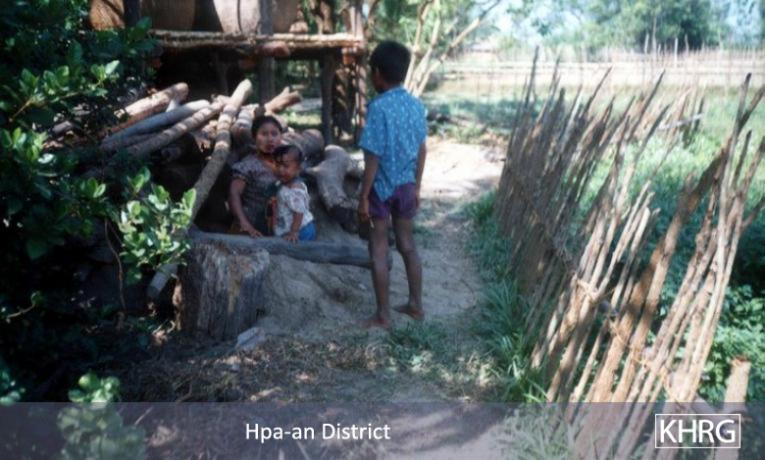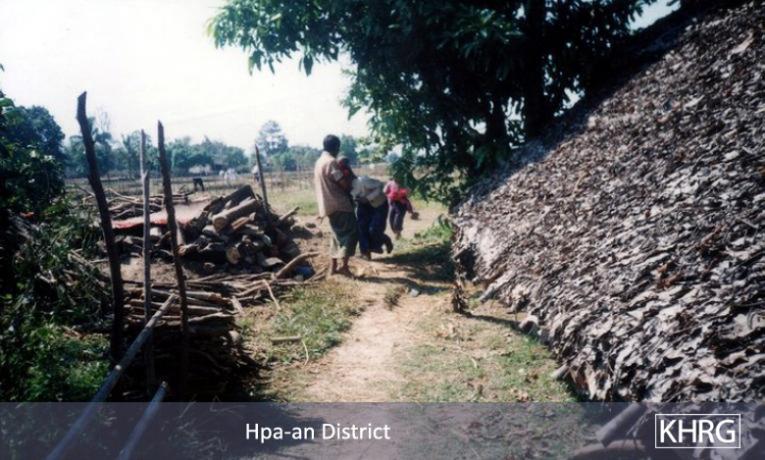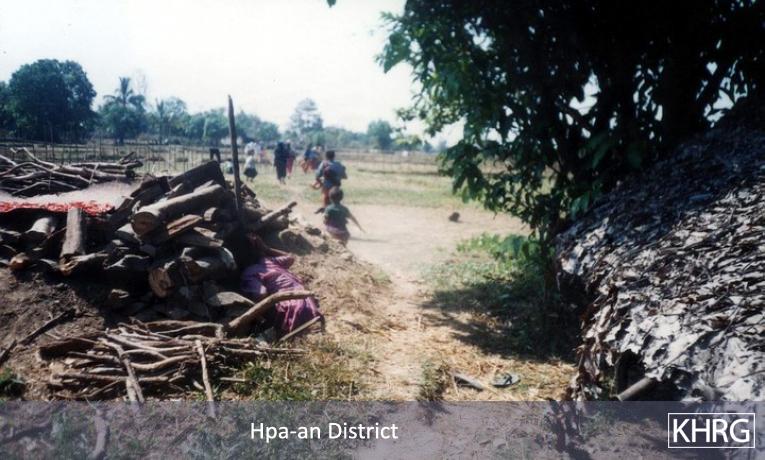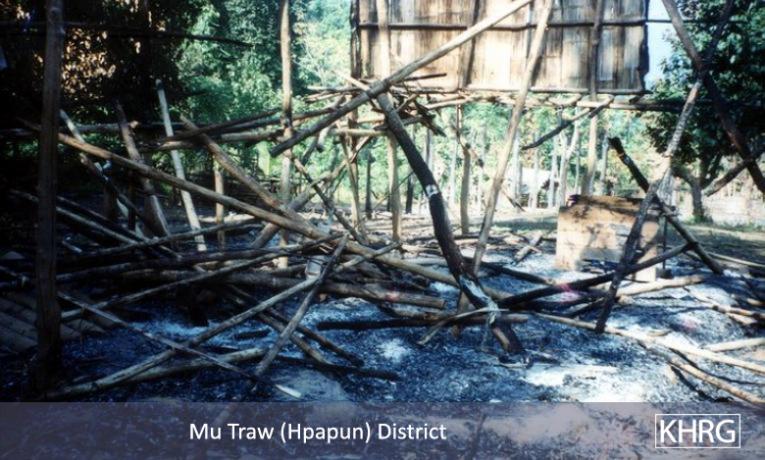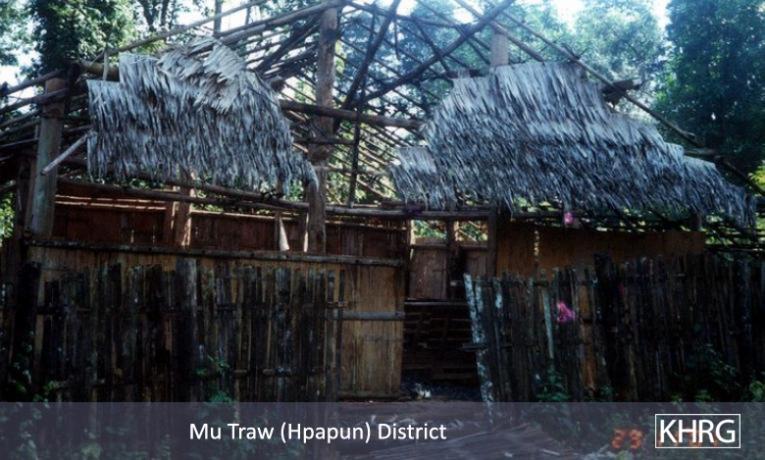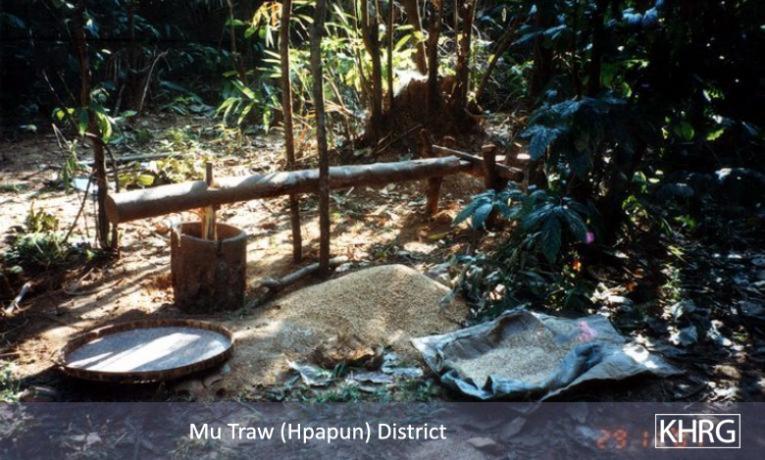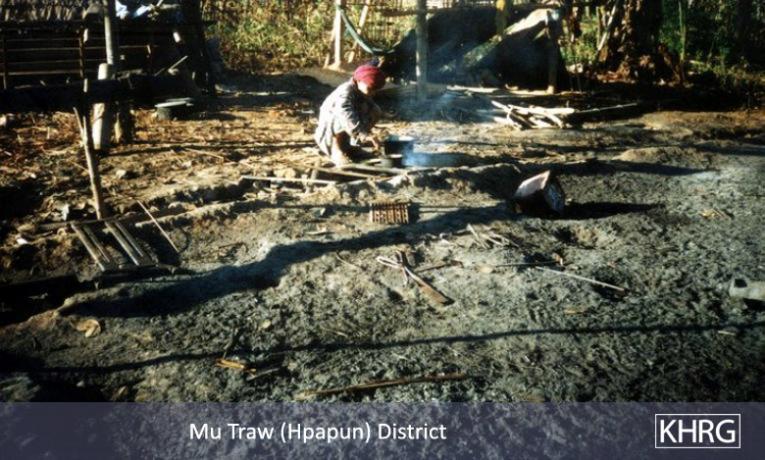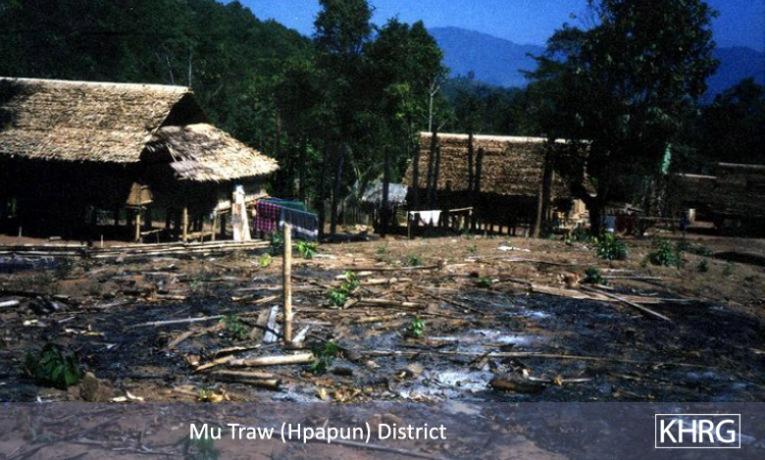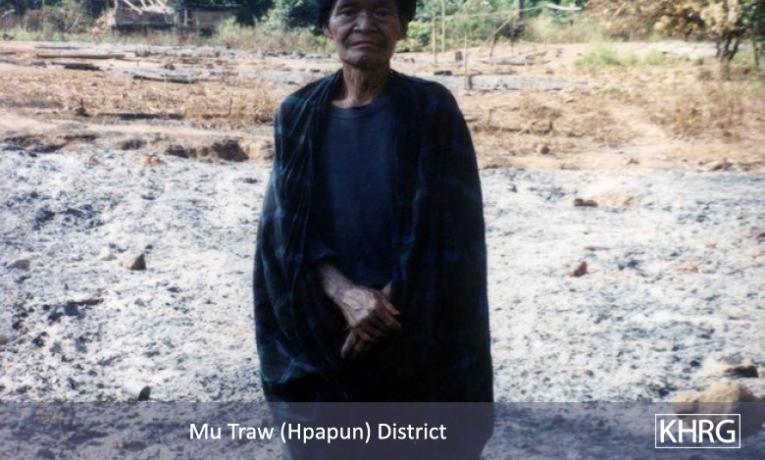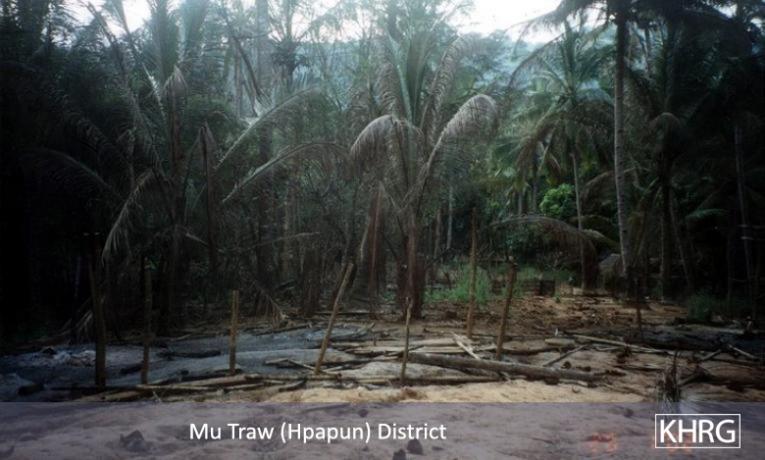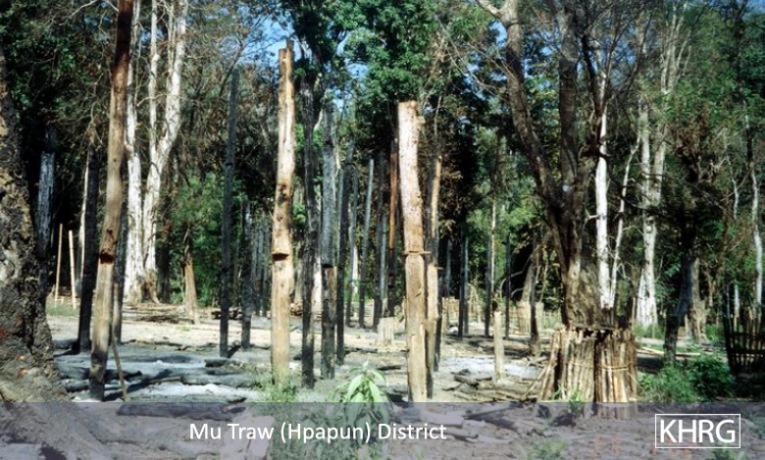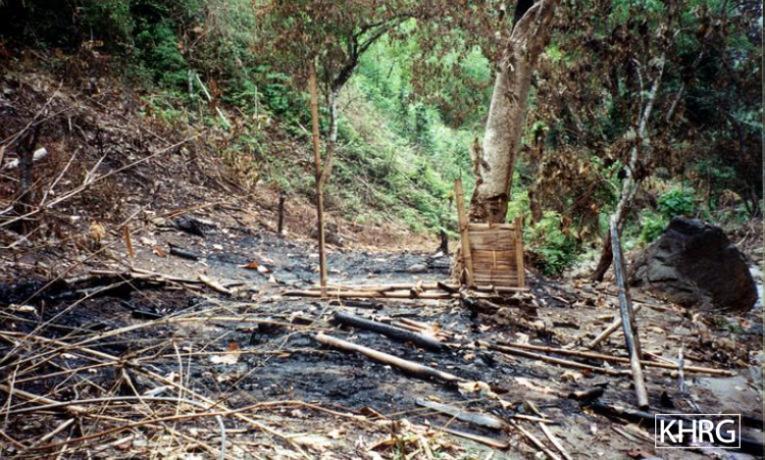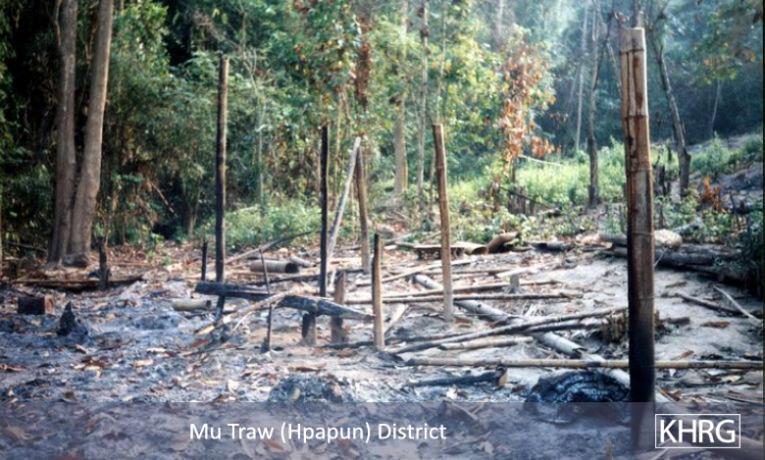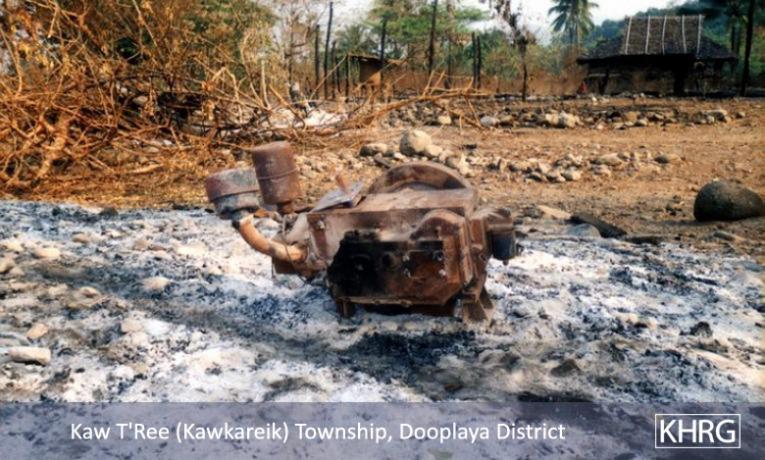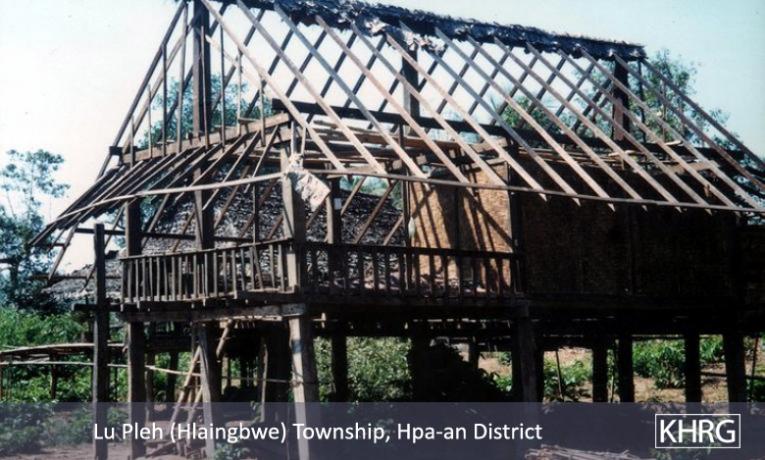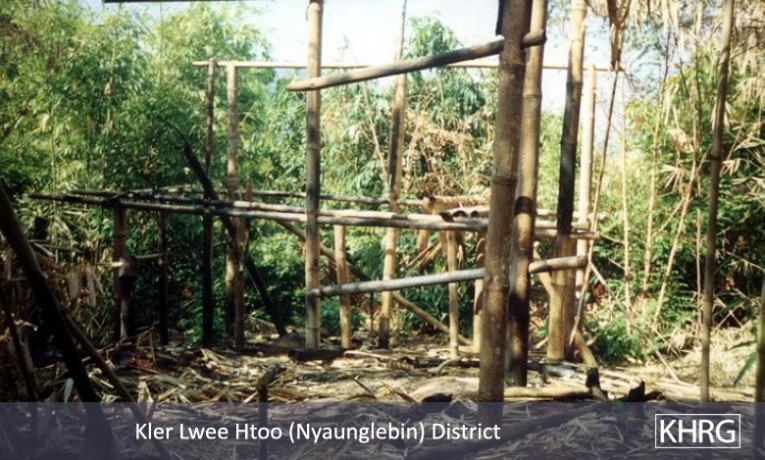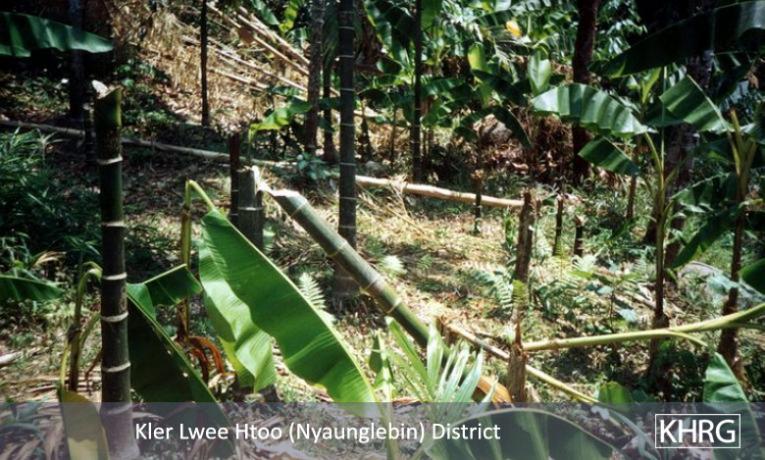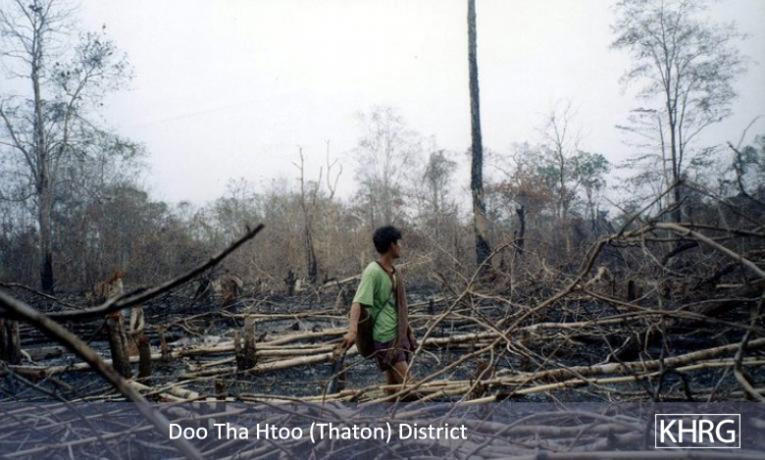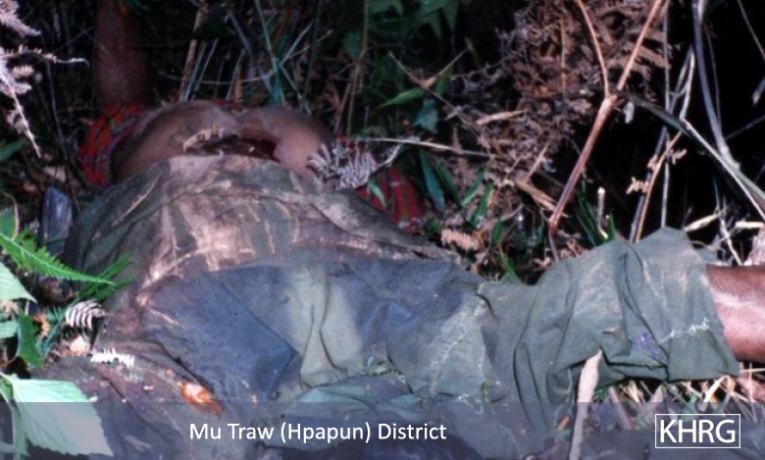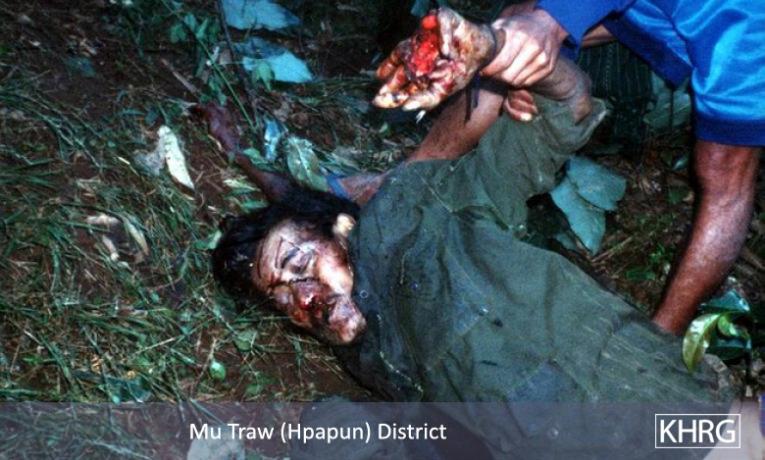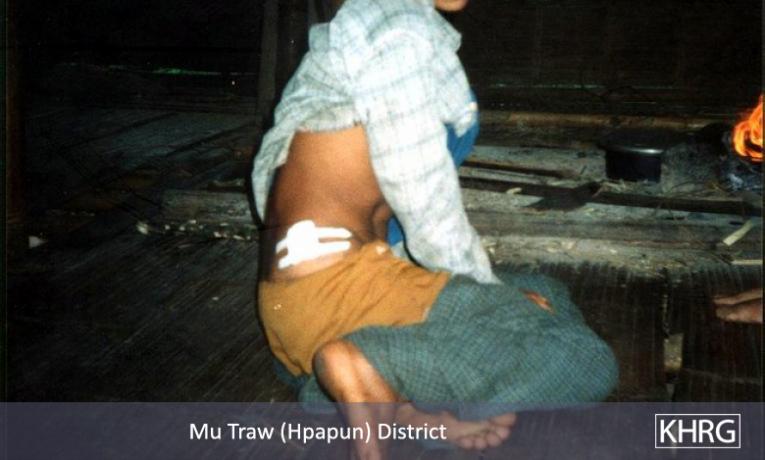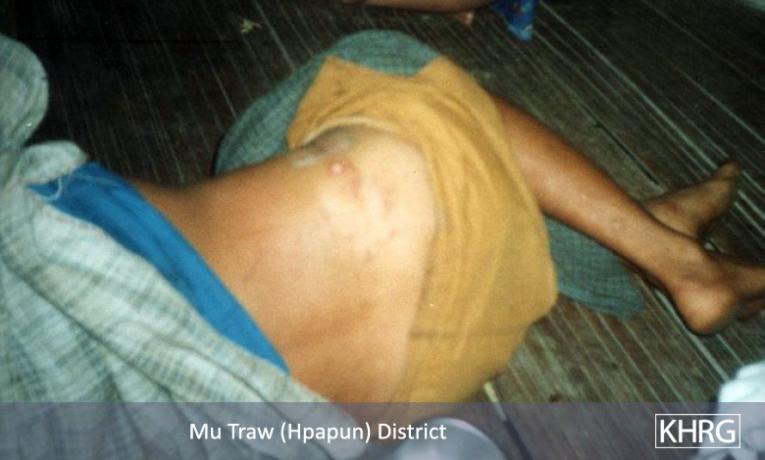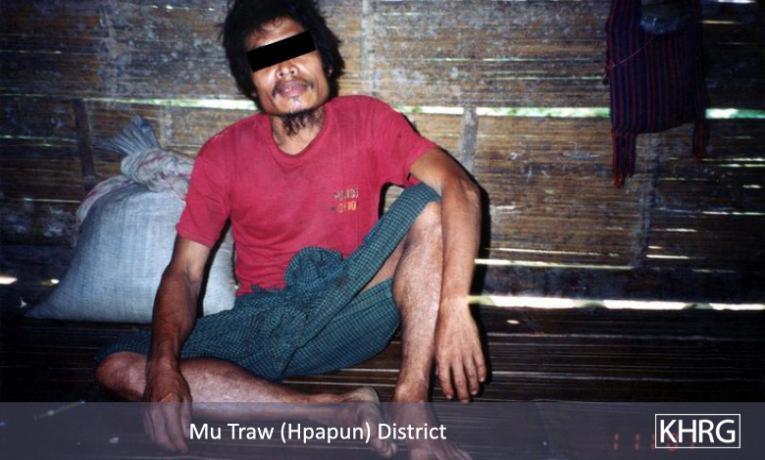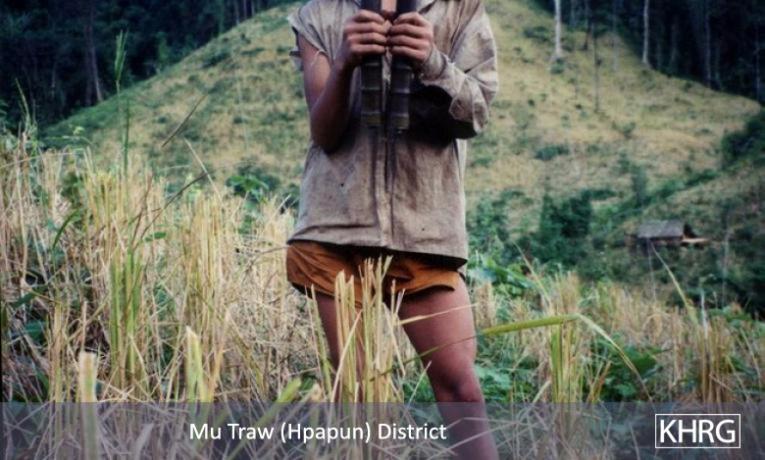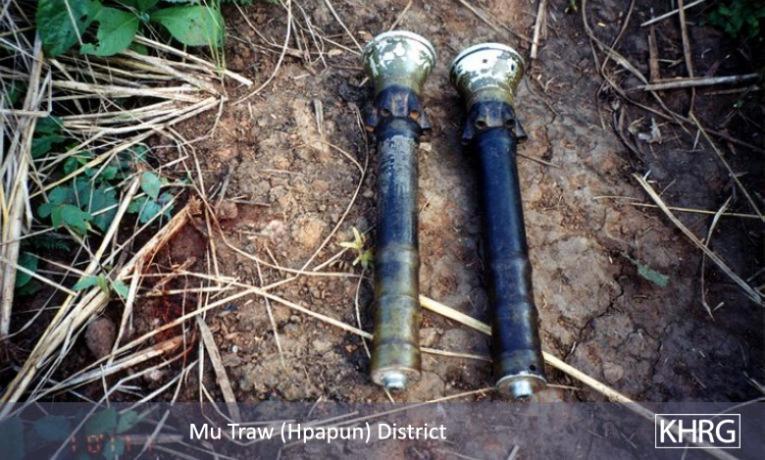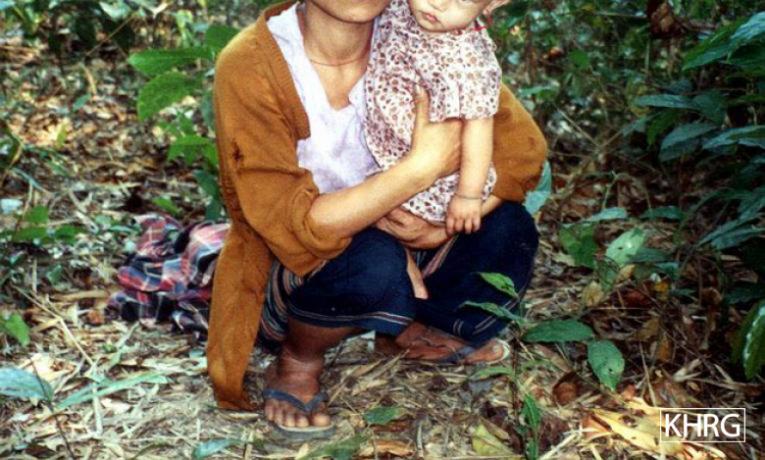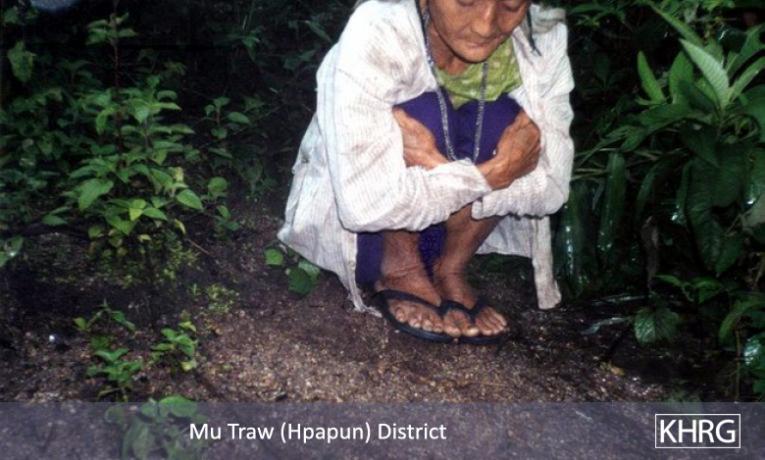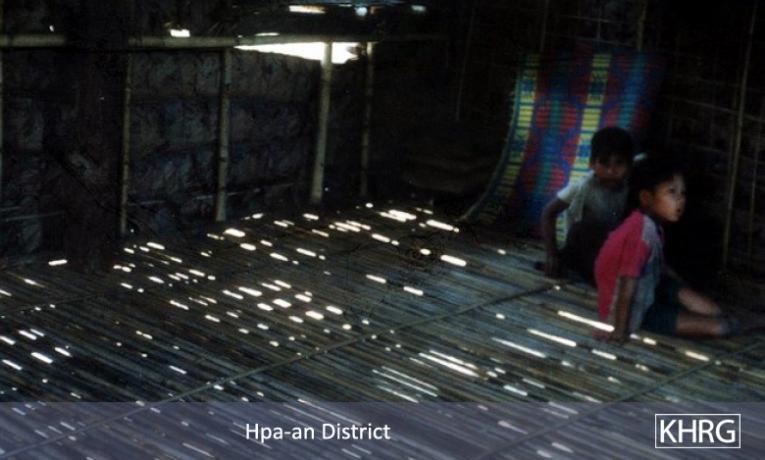This brief report and accompanying photo set details the destruction and attacks on villages in Karen State, Easter Pegu Division and Tenasserim Division in 2001 and 2002.
Hundreds of villages throughout the Karen areas of Karen State, eastern Pegu Division and Tenasserim Division lie deserted or burned to the ground, their populations having fled to the forest. In regions where resistance forces are believed to be active, it has become routine SPDC policy to burn and destroy villages and food supplies and to try to force villagers to relocation sites and garrisoned villages where they can be tightly controlled. Many villagers have been forcibly relocated several times in the past 20 years and would rather live in the forest than go again. They know that they can expect to find no food or assistance of any kind, no paid labour, no land to work and plenty of forced labour in the relocation sites, and that the conditions will eventually force them to flee into the forest anyway. After a while the villagers reestablish their villages, only for them to be burned when they are ordered to relocate once more. In Papun and eastern Nyaunglebin districts the SPDC has not even bothered to issue relocation orders to many villages, but has shelled and burned without warning over 200 villages since 1997. Hundreds more have been destroyed in other regions, displacing at least one to two hundred thousand people. Many of them are still in hiding in the forests, where columns come to burn their shelters and destroy their food supplies.
To force the villagers to come down out of the mountains and come under SPDC control, the army is actively pursuing a campaign of burning and destroying houses (see Photos #B5 through B67), destroying crops and food supplies and shooting displaced villagers on sight. The soldiers destroy the villager's crops before they can harvest them by trampling, uprooting or burning them. Landmines are also laid in the fields to keep the villagers away. Fields are also burned off too early before planting season to prevent the villagers from planting a crop (see Photos #I10 through 19). The villagers' rice storage barns are specifically targeted by the soldiers who carry off whatever they can and dump on the ground or burn what is left (see Photos #I21 through 26).
Villages under SPDC control are also subject to attacks by SPDC troops. Houses are looted and villagers' livestock and poultry taken (see Photos #B68 and 69, B71 through 73). Columns also 'punish' villages by shelling or shooting into them after a skirmish with resistance forces, or come to a village and shoot it up if the village head has failed to send the requested number of porters. Villagers have been killed and wounded by these attacks. Photos #D4 through D7 show the effects after an SPDC column opened fire on a group of villagers in a field hut, and Photos #D21 through D25 were taken after SPDC troops opened fire on a Christian worship service. Occasionally, villagers are caught in the crossfire when SPDC and resistance troops encounter each other in or around the same village. Many villagers build bunkers beside their houses and schools in case of fighting or random shooting and shelling by SPDC troops (see Photos #B1 through B4, B76).
Photos #B1, B2, B3, B4: Villagers from xxxx village, Pa’an District, run and hide in their bunkers during fighting between KNLA and SPDC/DKBA soldiers in early 2002. The fighting occurred about 150 metres from the village and lasted from 9:30 a.m. to 3:20 p.m. When the shells and bullets began to get too close the villagers were forced to run out from their bunkers and into the nearby forest (Photos #B3 and B4). None of the villagers were killed or wounded during the fight. [Photos: KHRG researcher]
Photo #B5: Naw H---, 40 years old, standing in the ashes of her house in xxxx village of eastern Papun District. Her house was burned down by SPDC soldiers on August 6th 2001. [Photo: KHRG researcher]
Photos #B6, B7, B8, B9, B10, B11, B12, B12: The remains of Lay Wah village, Papun District after SPDC soldiers of Tactical Operations Command #333, LID#33 under commander Than Lat left the village. When the SPDC soldiers began operating in western Papun District the villagers did not think that the soldiers would come to Lay Wah village, but they went and hid their belongings outside the village anyway. In mid-November 2001 the soldiers came close to the village and began operating in the area so the villagers fled the village. The soldiers stayed in the area for about 10 days and found and ate or destroyed much of the villagers’ food and belongings. The soldiers slept there for six nights during which they looted the villagers’ belongings and took whatever they saw; pigs, goats, chickens, clothes and iron tins. What they did not take they ate, destroyed or burned. The soldiers took a heavy rice-husking mortar (Photo #B9) from the village up the mountain above the village and pounded the villagers' paddy so they could eat it. They destroyed whatever paddy they were unable to eat. At 9:30 in the morning on November 27th 2001 the soldiers burned 17 houses in Lay Wah village as they left. Only the few houses which were farther out from the village centre were left. Photo #B11 is the remains of the village church. In the foreground of photo #B12 are the remains of the village school. This photo was taken a few months later after the villagers had rebuilt some of their houses. [Photos: KHRG researcher]
Photos #B14, B15, B16, B17: Karen villagers Saw K--- (41 years old), Saw H--- (63 years old), Saw L--- (30 years old) and Saw K--- (70 years old) from Lay Wah village, Papun District, stand in front of the ashes of one of the houses. These are some of the villagers whose belongings were looted or destroyed and houses burned by Tactical Operations Command #333, LID #33 in November 2001 when they swept through the area destroying villages and 'clearing' it of the civilian population. [Photos: KHRG researcher]
Photo #B18: The church at Maw Lay Kee, now abandoned after the villagers fled SPDC troops who came through the area in November-December 2001. [Photo: KHRG researcher]
Photos #B19, B20, B21: The remains of houses in Kler Lu (Photo #B19), Pway Lu (Photo #B20) and Thay Wee Kloh (Photo #B21) villages after SPDC soldiers burned them on December 18th 2001. These villages are in eastern Papun District. [Photos: KHRG researcher]
Photos #B22, B23, B24: The remains of houses in Kay Hta village, eastern Papun District. SPDC soldiers of LIB #341 and IB #19 entered and burned Kay Hta village on December 21st 2001. The soldiers also burned all nine paddy barns in the village. [Photos: KHRG researcher]
Photos #B25, B26: On January 16th 2002, Commander Moe Kyo of DKBA #999 Brigade burned down houses in Loh Baw village, Pa’an District. The DKBA soldiers also destroyed the piles of straw which the villagers had gathered to feed their cattle (Photo #B26). [Photos: KHRG researcher]
Photos #B27, B28, B29: On January 18th 2002, DKBA soldiers of DKBA #999 Brigade burned down houses and and destroyed the villagers' paddy in Day Law Pya village, Pa’an District. [Photo: KHRG researcher]
Photos #B30, B31, B32: The remains of houses and a straw pile burned by DKBA soldiers in Meh Pleh Wa village in early 2002. [Photos: KHRG researcher]
Photos #B33, B34: SPDC soldiers of IB #230 led by Battalion Commander Lwin Soe fought with KNLA soldiers beside the Hanthayaw River in Kya In township, Dooplaya District on November 20th 2001. After the fight, the SPDC soldiers burned and destroyed the nearby huts, straw and sugar cane plantations of the villagers. The straw was being kept to feed the cattle in the rainy season. [Photos: KHRG researcher]
Photo #B35: Villagers from Mu Kee village, Nyaunglebin District who have come back to look through the remains of their village which was burned down by SPDC soldiers in early 2002. [Photo: KHRG researcher]
Photos #B36, B37: On February 15th 2002 at 2 p.m., SPDC troops of LIB #361 came to this internally displaced villager hiding site in Nyaunglebin District and burned down the houses of Saw M---, Saw P--- and other villagers. The ashes of their houses can be seen in the centre of Photo #B36. In Photo #B37, Saw M--- looks through the remains of his burned house to see if there is anything that might be salvageable. [Photos: KHRG researcher]
Photo #B38: On March 12th 2002, SPDC soldiers of LIB #207 entered Kheh Pa Hta village, western Papun District and burned it. The smoke from the burning village can be seen in the valley in the centre of the photo. The villagers fled further into the forest to avoid the soldiers. [Photo: KHRG researcher]
Photos #B39, B40, B41: The remains of houses in Kheh Pa Hta village, western Papun District after SPDC troops razed it in March 2002. [Photos: KHRG researcher]
Photo #B42: A villager sifts through the ashes of his house in Kheh Pa Hta village, western Papun District. SPDC soldiers burned the village on March 12th 2002. [Photo: KHRG researcher]
Photo #B43: Naw E---, a 40 year old Karen animist hill field farmer from Per Kee Der village in Papun District, surveys the remains of her house. A column of SPDC troops from LIB #207, LID #44 under column commander Myint Thein came to the Per Kee Der villagers’ hiding place at xxxx and burned it on March 13th 2002. [Photo: KHRG researcher]
Photos #B44, B45, B46, B47, B48: The remains of houses in Kho Kay village after SPDC soldiers burned it on May 8th 2002. The soldiers also burned the paddy barns and destroyed whatever possessions they found hidden in the forest around the village. The village was an internally displaced villager hiding site which had become like a village because the villagers had been able to live there with a degree of stability for some time. Although the houses were built in clusters within site of each other and not next to each other, the soldiers went around and burned all of them except for one small hut (Photo #B45). [Photos: KHRG researcher]
Photo #B49: The remains of a clinic built by the KNU at Oo Da Hta near the Salween River in Papun District. The clinic was built to provide medicine and some measure of health care to villagers in the area. The clinic was only temporary because of the possibility of SPDC troops moving into the area. The SPDC came and burned it in early May 2002 at the same time that they burned Kho Kay village. [Photo: KHRG researcher]
Photos #B50, B51: A Wa Baw Kee villager looks through the remains of his house in eastern Papun District to salvage anything useful after SPDC troops from LIB #341 burned the village on February 26th 2002. [Photos: KHRG researcher]
Photo #B52: Saw B--- sits in the ashes of his house in Paw Hta village, eastern Papun District, in early 2002. He had come back with his family to see what had happened to their house and whether they could salvage anything. [Photo: KHRG researcher]
Photo #B53: When villagers returned to Paw Hta village in eastern Papun District after SPDC troops had left the area, they found this graffiti written on the beams of an unburned house. The words written by SPDC soldiers of IB #2, LID #44 read: “‘Flee until you are safe. The day that you tire is the day you will die.’ Nga Pway [‘Ringworm’; SPDC slang for the KNU] 44” The message on the beam behind reads: “Exchange arms for peace, brothers.” [Photo: KHRG researcher]
Photo #B54 B55, B56, B57, B58: On February 28th 2002, LIB #416, Battalion Commander Win Kyaw Oo, and LIB #83, Battalion Commander Min Naung, of LID #88, commander Ohn Myint, came to K’Toh Hta village in Kawkareik township, Dooplaya District. They accused the villagers of helping the KNLA and burned the entire village. Photo #B54 shows some of the small shelters that villagers built after the village was burned. In Photo #B55 the K’Toh Hta villagers received rice from sympathetic villagers from nearby villages. Photos #B56 and B57 show the remains of the villagers’ houses and photo #B58 is their rice mill after the attack. [Photos: KHRG researcher]
Photo #B59, B60: Deserted houses in K’Law Lu village, Pa’an District, after DKBA soldiers forced the villagers to leave the village in October 2001 and burned some of the houses. The DKBA laid landmines in the village after the villagers left and now the villagers are afraid to go back. [Photo: KHRG researcher
Photos #B61, B62: These houses in Lu Pleh township, Pa’an District were formerly the houses of the families of KNLA soldiers. The DKBA came during 2002 and threatened the families of known KNLA soldiers. The families do not dare to go back to their houses anymore and have moved to stay at an internally displaced villager site near the Thai border. [Photos: KHRG researcher]
Photo #B63: The deserted market area of K--- village, Papun District. On August 11th 2001, SPDC soldiers of IB #340 under Saw La Maung and DKBA soldiers opened fire on the market place forcing the people to flee and leave behind all of their goods and money. The soldiers then looted the market. This market had previously been used by internally displaced villagers and villagers from SPDC-controlled villages to trade goods for food. The attack was aimed at stopping this trade as well as simple looting. [Photo: KHRG researcher]
Photos #B64, B65: The remains of houses in Du Pah Leh village, Nyaunglebin District, destroyed by SPDC soldiers of LIB #20 in early 2002. This photo was taken on April 16th 2002. [Photos: KHRG researcher]
Photo #B66, B67: The remains of houses in Loh Kee village, Nyaunglebin District after SPDC soldiers of LIB #367, Sa Ka Ka #10 burned it in March 2002. The soldiers then went and cut down the villagers' betel nut trees. The villagers trade the betel nuts for rice and other foodstuffs from SPDC-controlled villages. [Photo: KHRG researcher]
Photo #I10: Hill fields in Papun District that were burned off prematurely by SPDC soldiers in early 2002. The uneven burn leaves the farmer with only small portions of his hill field which are plantable. Hill fields only produce enough rice to enable a family to get by from year to year. Without the full use of the field farmers must stretch their own rice farther and find rice elsewhere to supplement what little they will be able to get from their field. [Photo: KHRG researcher]
Photos #I11, I12, I13, I14: These fields belonging to villagers from K--- village in Thaton District were burned off prematurely by SPDC soldiers of LID #44, LIB #118, Column #1 under Battalion Deputy Commander Saw Leh Soe on March 13th 2002. [Photos: KHRG researcher]
Photos #I15, I16: Soldiers from LIB #118, LID #44 came through L--- village, Thaton District, on March 4th 2002 and burned all of the villagers' fields that they saw next to the road. [Photos: KHRG researcher]
Photos #I17, I18, I19: These fields in L--- and H--- villages in Thaton District were burned by SPDC soldiers of LIB #118 on March 14th 2002. [Photos: KHRG researcher]
Photo #I20: The remains of a sugar cane field in eastern Papun District. SPDC soldiers ate or destroyed all the sugar cane when they stayed nearby in early 2002. No compensation was given to the villagers. Crops like sugar cane are grown by the villagers both for their own consumption and to sell or barter for rice or other foodstuffs. [Photo: KHRG researcher]
Photo #I21: Photo of Saw P---’s rice barn which was destroyed by SPDC soldiers in Papun District in December 2001. [Photo: KHRG researcher]
Photo #I22: Paddy which has been left behind by H--- villagers fleeing SPDC columns which have come to operate in Papun District. They did not dare to go back and take the paddy out of fear of being shot by the patrolling soldiers. [Photo: KHRG researcher]
Photos #I23, I24: Paddy which M--- villagers in Papun District had to leave behind when they fled. It was found by SPDC troops, who took some, threw some on the ground (Photo #I23), and piled some on cooking fire pits within the houses to try to burn it (Photo #I24). [Photos: KHRG researcher]
Photo #I25: The remnants of M---’s paddy, burned by soldiers of LIB #361 on February 15th 2002 in Nyaunglebin District. All 70 baskets [1,750 kgs. / 3,850 lbs.] of paddy were destroyed. This will leave M---’s family with very little, if any, food for the year. They will likely have to beg for food from others, buy food from another village or try to flee to a refugee camp in Thailand. [Photo: KHRG researcher]
Photo #I26: Naw S--- looks for any paddy that may be saved after SPDC soldiers burned down her paddy barn in M--- village in Papun District in 2002. There were 50 baskets [1,250 kgs. / 2,750 lbs.] of paddy in the barn. [Photo: KHRG researcher]
Photo #I27: SPDC soldiers of LIB #341 stabbed this villager's pot with their bayonets to make it useless. The pots had been left behind by displaced villagers fleeing SPDC soldiers in Papun District in early 2002. [Photo: KHRG researcher]
Photos #B68, B69: On February 12th 2002, LIB #102, LID #44 entered Toh Nyo village and looted the villagers’ belongings. They took machetes, clothes, pigs, chickens, coconuts and rice and did not pay for anything. The feathers under the tree are what remains of the chickens the soldiers killed and plucked to cook for their meal (Photo #B68). The soldiers slept in the village for a night and the next day went back to Paw Hta (Photo #B69) where they also stole the villagers’ belongings. SPDC soldiers climbed the coconut trees to steal the coconuts, drank the water from the coconuts and threw the rest away. The feathers on the ground are from chickens that they also stole and ate. These photos were taken the following day. [Photos: KHRG researcher]
Photo #I34: This woman in xxxx village, Papun District is putting her rice into tins to hide it the next time SPDC soldiers come to the village. The SPDC entered the village one or two days previously and had taken much of the villagers' rice, clothing and other things. The xxxx villagers face the SPDC but they are afraid of them. The soldiers do whatever they want to the villagers and the villagers do not dare to say anything to them. [Photo: KHRG researcher]
Photo #B70: These sesame fields in xxxx village, Dooplaya District were damaged by IB #231 under Battalion Commander Myint Han and Deputy Battalion Commander Myo Myint. They came with a bulldozer, a six-wheeled truck and three bullock carts and drove them across the unharvested fields destroying part of the villagers’ crop. No compensation was paid for the damage. Cash crops such as sesame are grown by the villagers to sell or barter for rice or other foodstuffs to supplement their diets or for cash to pay the various fees demanded of them. [Photos: KHRG researcher]
Photos #D4, D5, D6, D7: A group of villagers from Tee Law Bler village in Dooplaya District tried to flee to Thailand after being ordered to relocate in April 2002. They spent the night of April 28th in some rice field huts not far from their village. Soldiers of IB #78 found the villagers asleep in the huts and without investigating who was inside opened fire on them. Ten people were shot dead, six of them children: Saw Toh Paw (age 56), his wife Naw Hsa Ghay (51), their granddaughters Naw K'Ree Htoo (12) and Naw Bleh Po (5), Ma Htwe Yi (50), Naw Mu Tha (40), Mu Bpaw Bpaw (7), Saw K'Pru Mu (14), Naw Plah (5) and Naw Dta Baw (2). All but Saw Toh Paw and Saw K'Pru Mu were women and girls. Nine other villagers were wounded and left there by the soldiers. Naw Pee Lee, 45 years old, (Photos #D5 and D6) from Tee Law Bler village, was shot in the left breast. She was eight or nine months pregnant at the time. Her husband tried to care for her in the forest and after ten days she gave birth but the baby died immediately. She also died three days later on May 10th. Two of her five children had been among those who died in the initial barrage. The young boy in Photo #D7 was lucky to escape with only the injury to his left arm, although he will bear the scars of the attack physically and mentally for the rest of his life. [Photos: FBR]
Photos #D21, D22, D23, D24, D25: The bodies of Saw H---, Saw D--- and Saw S--- who were shot dead by SPDC soldiers near xxxx village, northern Papun District. Soldiers of LIB #xxx and IB #yy had come down from Toungoo District in the north into Papun District. After shooting at villagers in their fields at yyyy and zzzz villages, the soldiers came to xxxx village on November 20th 2001. The villagers were holding a Christian worship service and did not know that the soldiers were approaching. When the soldiers opened fire the villagers scattered and ran away. Three children, Naw S---, 17 years old, Saw H---, 6 years old, and Saw T---, 8 years old, became separated from the other villagers and were lost in the forest for a day. Three of the villagers were killed. Saw D--- and Saw S--- (Photos #D22, D23, D24, D25) were shot together. Saw H--- (Photo #D21) the xxxx village head, was shot separately. All three men had children. The villagers went back after the soldiers had left, found the three men and buried them. [Photos: KHRG researcher]
Photos #D30, D31, D32, D33, D34, D35: Saw P--- (Photo #D33) is the village head of xxxx village in western Papun District. On October 11th 2001 at 3 o’clock in the afternoon, the 50 year old hill field farmer was in his field hut with his son, Saw K---, 15 years old (Photo #D30), when soldiers from a combined column of IB #xx, Column #x under Battalion Commander T--- and LIB #xxx commanded by A--- and deputy commander L--- opened fire on them. Saw K--- was injured by a piece of shrapnel in the waist (Photos #D31 and D32). No one else was injured and everyone was able to escape. In Photo #D34, Saw K--- is holding the tail sections of the rocket propelled grenades that the soldiers shot at him. Photo #D35 is a closer look at the tail sections. [Photos: KHRG researcher]
Photo #D63: Xxxx villager Naw M---'s husband was shot dead by SPDC troops of LIB #xx under Company Commander T--- on January 7th 2002. The soldiers saw Saw P--- running when they entered the village and immediately shot and killed him. The soldiers then searched the houses in the village and looted everything from the houses in the village. [Photo: KHRG researcher]
Photo #D65: Naw W---, a villager from xxxx village, was wounded when SPDC troops fired mortars into her village during fighting in the yyyy area of Pa’an District on April 8th 2002. She has an eight month old baby. This photo was taken on April 11th 2002. [Photo: KHRG researcher]
Photo #D66: During fighting in the yyyy area of Pa’an District on April 8th 2002, SPDC mortar rounds fell in the yyyy monastery grounds wounding this monk. This photo was taken on April 17th 2002. [Photo: KHRG researcher]
Photos #E10, E11: These two women, Naw L--- (50 years old) and Naw H---, fled from W--- village in Papun District when SPDC soldiers opened fire on the village. Naw L--- became lost in the forest and was not found until three days later. [Photo: KHRG researcher]
Photo #E16: Saw K---, 25 years old, from K--- village, Papun District. On August 3rd 2001, SPDC soldiers from LIB #xx under Battalion Commander H--- opened fire on and then entered K--- village. The 80 people living in the village where forced to flee into the forest. Saw K--- had to carry his children and was unable to take any of his food. He was forced to drop all of the pots and clothing that he was carrying when they had to cross a river. He now has nothing left and has to borrow pots from his friends when he wants to cook. [Photo: KHRG researcher]
Photo #E25: Saw L---, 62 years old, is the village head of xxxx village, northern Papun District. He told KHRG researchers how on December 2nd 2001 SPDC soldiers from LIB #503 and IB #7 came to xxxx village and opened fire. Another villager, Saw P---, was injured in the left shoulder. Most of the villagers were able to take their belongings and run away, but the soldiers captured Naw P---, 50 years old, and took her with them for four hours. They then forced her to sit down, touched her with a gun and asked, “Do you want to die?” She told them, “If you want to kill me don’t torture me, just kill me immediately. I am already old. In my life I have only worked a hill field, but now I can’t work to get food anymore.” The soldiers then released her. [Photo: KHRG researcher]
Photo #B71: The monastery in xxxx village where villagers had been keeping their belongings to keep them safe from looting SPDC soldiers. However, SPDC soldiers from Column #2 of Ya Ta Ma #102 under column commander Aung Kyaw Moe and column second in command Win Naing came to the village on March 4th 2002 and took everything in the monastery after first searching all of the houses. [Photo: KHRG researcher]
Photos #B72, B73: Villagers look through their chests for anything that remains after SPDC soldiers looted and burned possessions that they had hidden in a hut in Papun District. [Photos: KHRG researcher]
Photos #B74, B75: Two houses in xxxx village, southeast Pa’an District. A researcher from the area reported that 15 years ago the houses in this village were big and made of wood, but now there are no big houses anymore and the forests are gone. The villagers simply build small houses to stay in. The villagers no longer try to build big, wooden houses anymore because they no longer have the money and they see little point in building a house which may be destroyed. They simply make them with bamboo floors and leaf walls. Villagers only build houses with leaf walls as a last resort when there is no more wood or bamboo. When a researcher asked the owner of the house in Photo #B74 why he did not build a good house, he replied, "If I make a good house and there is fighting, the SPDC and DKBA will burn it and I will be sorry to lose the house.” SPDC and DKBA troops often burn villager's houses as punishment when fighting occurs in the area. [Photo: KHRG researcher]
Photo #B76: This bunker was built by villagers in xxxx village, Pa’an District, to flee into if fighting broke out near the village. The logs have been placed on the top of the bunker for extra protection. [Photo: KHRG researcher]

